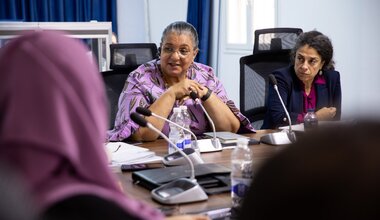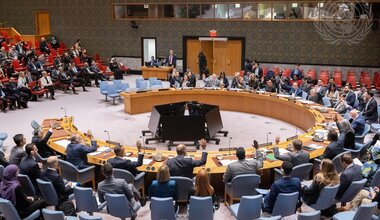Human Rights Report on Civilian Casualties - April 2017
Tunis– From 1 April to 30 April 2017, the United Nations Support Mission in Libya (UNSMIL) documented 28 civilian casualties - 26 deaths and 2 injuries – during the conduct of hostilities across Libya. Victims included 22 men killed and 1 injured, 1 woman killed and 1 injured, and 2 children killed.
Civilian Casualties
The majority of civilian casualties were caused by gunfire (12 deaths and 2 injuries), followed by airstrikes (6 deaths), shelling (4 deaths), and Explosive Remnants of War (4 deaths).
UNSMIL documented 9 deaths in Tarhouna, 7 deaths and 2 injuries in Benghazi, 7 deaths in Sabha, 2 deaths in Sirte, and 1 in Tripoli.
The civilian casualties included 5 detainees, held by a Tabu armed group, killed when their detention facility was hit during airstrikes on several locations in Sabha on 24 April. An Algerian migrant also sustained shrapnel injuries during the airstrikes and succumbed to his wounds on 26 April. At least 10 others were injured in the airstrikes, but UNSMIL has been unable to ascertain their civilian status. Shortly after the airstrikes, clashes broke out between armed groups in Sabha, leading to the death of a 10 year-old girl in crossfire.
There were civilian casualties in Benghazi, including 1 woman killed and 1 man and 1 woman injured by gunfire on 2 April and 4 men killed when the neighborhood of Juliyana was hit on 20 April, apparently by artillery. On 6 April, one civilian was also shot dead in Tripoli.
On 17 April, the al-Kani armed group opened fire on a family in the city of Tarhouna, leading to the deaths of a 7 year-old girl, an elderly paralyzed man and 9 other men, and to the injury of 2 men and a 14 year-old boy. UNSMIL has been unable to ascertain the civilian status of 3 of the 9 men killed and 2 of the persons injured. On 21 April, members of the al-Kani armed group reportedly summarily executed one of the injured men, while he was receiving treatment at the Tarhouna hospital. Reports indicate that a number of males from the Tarhouna family might have exchanged fire with the al-Kani armed group, and that at least 7 men were summarily executed. UNSMIL has called for investigations into the incidents with a view to bringing those responsible to justice.
Civilian Facilities
On 15 April, unknown assailants looted the al-Awal radio station in Surman, before setting it on fire.
During April, the al-Zawiya main hospital was closed twice due to armed clashes in the vicinity, between 8 and 10 April and again between 19 and 21 April. On both occasions, patients were evacuated.
On 19 April, a man died as a result of shrapnel wounds when a grenade was thrown inside the grounds of the Faculty of Medicine in al-Zawiya. Another sustained a gunshot wound during the clashes. The Faculty of Medicine closed for several days following the incident.
Attribution
While no one claimed responsibility for the airstrikes, reports indicated that the LNA carried out the airstrikes that caused civilian casualties in Sabha. Members of the Abu Salim armed group under the command of Abdel Ghani al-Kikli, renamed the Central Security Directorate of Abu Salim, are believed to be responsible for the fatal shooting of a man in Tripoli on 6 April, while members of the al-Kani armed group are responsible for the killings in Tarhouna on 17 and 21 April. UNSMIL was unable to determine with certainty which parties to the conflict caused the other civilian casualties in April.
Other Casualties
On 1 April, a body of a male bearing a gunshot wound, broken ribs, and contusions was brought to the Benghazi Medical Centre. The man was reportedly arrested a day earlier by members of the al-‘Uruba Police Station in Benghazi.
On 19 April, a 19 year-old man was fatally shot in the neck outside a coffee shop in al-Zawiya. The motive behind his killing is unclear.
On 23 April, a Sirte resident was shot in the thigh following an argument with a man, who he believed to belong to a Misrata-based armed group.
Note
The figures for civilian casualties set out above only include persons killed or injured in the course of hostilities and who were not directly participating in the hostilities. The figures do not include those casualties that are not a direct result of hostilities, for example executions after capture, torture or abductions, or casualties caused as an indirect consequence of hostilities. The figures are based on information UNSMIL has gathered and cross-checked from a broad range of sources in Libya, including human rights defenders, civil society, current and former officials, employees of local governments, community leaders and members, witnesses, others directly affected and media reports. In order to assess the credibility of information obtained, where possible, UNSMIL reviewed documentary information, including medical records, forensic reports and photographic evidence.
The figures are only those that UNSMIL was able to document in the reporting period. They are not likely to be complete and may change as new information emerges about incidents involving civilian casualties that took place during this period.
Similarly, while UNSMIL has systematically tried to ensure that the cases it documented are based on credible information, further verification would be required to attain a higher standard of proof. Due to the security situation, UNSMIL has not been able to carry out direct site visits in Libya to obtain information. Disruption in communications especially in areas controlled by groups pledging allegiance to ISIL and fear of reprisals against sources further hamper information gathering.
While not all actions leading to civilian casualties breach international humanitarian law, UNSMIL reminds all parties to the conflict that they are under an obligation to target only military objectives. Direct attacks on civilians as well as indiscriminate attacks – which do not distinguish between civilians and fighters – are prohibited. Attacks that are expected to cause incidental loss of civilian life, injury to civilians and damage to civilian objects excessive to the anticipated concrete and direct military advantage are also prohibited. Such attacks amount to war crimes that can be prosecuted by the International Criminal Court.
In order to ensure greater protection of the civilian population and essential infrastructure, all parties engaged in fighting in Libya must cease the use of mortars and other indirect weapons and imprecise aerial bombardments in civilian-populated areas, and not place fighters or other military objectives in populated areas. All executions of captives must cease and all those captured including fighters must be treated humanely in all circumstances. Murdering or torturing captives is also a war crime, regardless of what the captive may be accused of.
 United Nations Peacekeeping
United Nations Peacekeeping UN
UN









